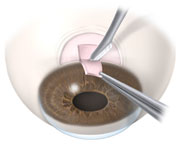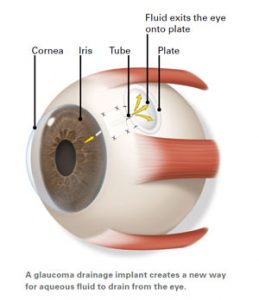Glaucoma damage is permanent—it cannot be reversed. However, medicine and surgery can help to stop further damage. To treat glaucoma, your ophthalmologist may use one or more of the following treatments.
Medication
Glaucoma is usually controlled with eye drops. Used daily, these eye drops lower eye pressure. Some do this by reducing the amount of aqueous fluid the eye makes, others reduce pressure by helping fluid flow better through the drainage angle.
 Glaucoma medications can help you keep your vision, but they may also produce side effects. Some eye drops may cause:
Glaucoma medications can help you keep your vision, but they may also produce side effects. Some eye drops may cause:
- a stinging or itching sensation
- red eyes or red skin around the eyes
- changes in your pulse and heartbeat
- changes in your energy level
- changes in breathing (especially if you have asthma or breathing problems)
- dry mouth
- blurred vision
- eyelash growth
- changes in your eye color, the skin around your eyes or eyelid appearance.
All medications can have side effects. Some drugs can cause problems when taken with other medications. It is important to give your ophthalmologist a list of all your chronic medication. Be sure to talk with your ophthalmologist if you think you may have side effects from glaucoma medicine.
Never change or stop taking your glaucoma medications without talking to your ophthalmologist. If you are about to run out of your medication, ask your ophthalmologist if you should have your prescription refilled.
 Laser surgery
Laser surgery
There are two main types of laser surgery to treat glaucoma. They help aqueous drain from the eye.
1. Trabeculoplasty. This surgery is for people who have open-angle glaucoma. The ophthalmologist uses a laser to make the drainage angle work better. That way fluid flows out properly and eye pressure is reduced.
2. Iridotomy. This is for people who have angle-closure glaucoma. The ophthalmologist uses a laser to create a tiny hole in the iris. This hole helps fluid flow to the drainage angle.
Trabeculectomy
This is where your eye ophthalmologist creates a tiny flap in the sclera (white of your eye). He or she will also create a bubble (like a pocket) in the conjunctiva called a bleb. It is usually hidden under the upper eyelid and cannot be seen. Aqueous humor will be able to drain out of the eye through the flap and into the bleb. In the bleb, the fluid is absorbed by tissue around your eye, lowering eye pressure.
Glaucoma drainage devices
Your ophthalmologist may implant a tiny drainage tube in your eye. It sends the fluid to a collection area (called a reservoir). Your eye surgeon creates this reservoir beneath the conjunctiva (the thin membrane that covers the inside of your eyelids and white part of your eye). The fluid is then absorbed into nearby blood vessels.
Your role in glaucoma treatment
Treating glaucoma successfully is a team effort between you and your ophthalmologist. Your ophthalmologist will prescribe your glaucoma treatment. It is up to you to follow your doctor’s instructions and use your eye drops.
Once you are taking medications for glaucoma, your ophthalmologist will want to see you regularly. You can expect to visit your ophthalmologist about every 3–6 months. However, this can vary depending on your treatment needs.
If you have any questions about your eyes or your treatment, talk to your ophthalmologist.
Article source
Read more about glaucoma on the South African Glaucoma Society website here.
